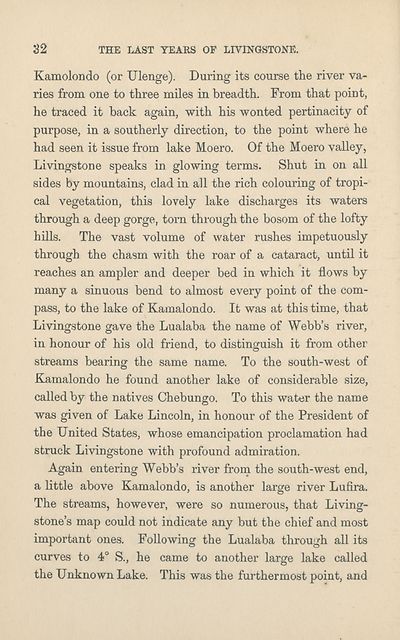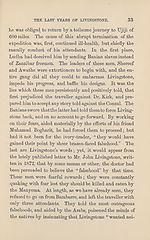Download files
Complete book:
Individual page:
Thumbnail gallery: Grid view | List view

32
THE LAST YEARS OF LIVINGSTONE.
Kamolondo (or Ulenge). During its course the river va¬
ries from one to three miles in breadth. From that point,
he traced it hack again, with his wonted pertinacity of
purpose, in a southerly direction, to the point where he
had seen it issue from lake Moero. Of the Moero valley,
Livingstone speaks in glowing terms. Shut in on all
sides by mountains, clad in all the rich colouring of tropi¬
cal vegetation, this lovely lake discharges its waters
through a deep gorge, torn through the bosom of the lofty
hills. The vast volume of water rushes impetuously
through the chasm with the roar of a cataract, until it
reaches an ampler and deeper bed in which it flows by
many a sinuous bend to almost every point of the com¬
pass, to the lake of Kamalondo. It was at this time, that
Livingstone gave the Lualaba the name of Webb’s river,
in honour of his old friend, to distinguish it from other
streams bearing the same name. To the south-west of
Kamalondo he found another lake of considerable size,
called by the natives Chebungo. To this water the name
was given of Lake Lincoln, in honour of the President of
the United States, whose emancipation proclamation had
struck Livingstone with profound admiration.
Again entering Webb’s river from the south-west end,
a little above Kamalondo, is another large river Lufira.
The streams, however, were so numerous, that Living¬
stone’s map could not indicate any but the chief and most
important ones. Following the Lualaba through all its
curves to 4° S., he came to another large lake called
the Unknown Lake. This was the furthermost point, and
THE LAST YEARS OF LIVINGSTONE.
Kamolondo (or Ulenge). During its course the river va¬
ries from one to three miles in breadth. From that point,
he traced it hack again, with his wonted pertinacity of
purpose, in a southerly direction, to the point where he
had seen it issue from lake Moero. Of the Moero valley,
Livingstone speaks in glowing terms. Shut in on all
sides by mountains, clad in all the rich colouring of tropi¬
cal vegetation, this lovely lake discharges its waters
through a deep gorge, torn through the bosom of the lofty
hills. The vast volume of water rushes impetuously
through the chasm with the roar of a cataract, until it
reaches an ampler and deeper bed in which it flows by
many a sinuous bend to almost every point of the com¬
pass, to the lake of Kamalondo. It was at this time, that
Livingstone gave the Lualaba the name of Webb’s river,
in honour of his old friend, to distinguish it from other
streams bearing the same name. To the south-west of
Kamalondo he found another lake of considerable size,
called by the natives Chebungo. To this water the name
was given of Lake Lincoln, in honour of the President of
the United States, whose emancipation proclamation had
struck Livingstone with profound admiration.
Again entering Webb’s river from the south-west end,
a little above Kamalondo, is another large river Lufira.
The streams, however, were so numerous, that Living¬
stone’s map could not indicate any but the chief and most
important ones. Following the Lualaba through all its
curves to 4° S., he came to another large lake called
the Unknown Lake. This was the furthermost point, and
Set display mode to:
![]() Universal Viewer |
Universal Viewer | ![]() Mirador |
Large image | Transcription
Mirador |
Large image | Transcription
| Antiquarian books of Scotland > Scotland/Scots > Last years of Livingstone > (40) |
|---|
| Permanent URL | https://digital.nls.uk/136057642 |
|---|
| Description | Thousands of printed books from the Antiquarian Books of Scotland collection which dates from 1641 to the 1980s. The collection consists of 14,800 books which were published in Scotland or have a Scottish connection, e.g. through the author, printer or owner. Subjects covered include sport, education, diseases, adventure, occupations, Jacobites, politics and religion. Among the 29 languages represented are English, Gaelic, Italian, French, Russian and Swedish. |
|---|

